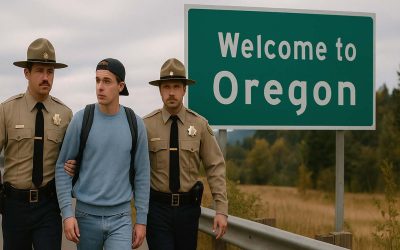It’s no surprise that camping fees in Oregon are rising, both at state parks and private campgrounds. While these increases may be necessary to keep up with the growing costs of maintaining these spaces, it’s making it harder for Oregon families to afford what used to be a budget-friendly outdoor getaway.
It's hard not to miss the days—seemingly not that long ago—when camping was much more affordable for families. You could head out for a weekend without worrying about breaking the bank. Back then, a camping trip was an easy and inexpensive way to connect with nature and spend quality time together. In the 1990s, the average cost to camp in an Oregon state campsite increased slightly compared to the 1980s. Fees generally ranged from $10 to $15 per night for a basic tent site, while campsites with amenities like electrical hookups, water, or improved facilities could cost closer to $15 to $20 per night. The rise in fees reflected inflation and the growing popularity of outdoor recreation in the state during that period. But now, with the constant rise in fees, camping feels more like a luxury, and families have to budget carefully just to enjoy a simple weekend outdoors.
RELATED: The Best Camping in Oregon: Our Top Campgrounds For 2024
Starting on October 15, 2025, new camping rates will take effect for all reservations made for the upcoming year. These increases include:
- A $2 increase for miscellaneous sites (such as tipis, meeting halls, and other facilities)
- A $3 increase for tent sites (including horse tent sites, group tent sites, and primitive camping areas)
- A $4 increase for RV sites (which covers full hookups, electrical sites, and group RV areas)
- A $5 increase for cabins and yurts, including rustic and deluxe options.
Currently, camping rates across Oregon state parks range from $17 to $38 depending on location and season, but these upcoming increases will push costs even higher. In addition to the overnight stay fees, starting January 1, 2025, the online reservation fee will increase from $8 to $10 per site, and the day-use parking permit—currently required at 25 of Oregon's 250 state parks—will double from $5 to $10. The annual and two-year parking permits will remain the same at $30 per year and $50 for a two-year permit, respectively.
To put this into perspective, let’s break down the costs of a 3-night camping trip for a family of four at a state park after the 2025 rate increases:
- $90 for three nights of camping at $30 per night
- $10 for the reservation fee
- $10 for the day-use parking permit
- $32 for gas (assuming a round trip of about 200 miles)
- $250 for food
The total cost of this state park camping trip would be approximately $392 for three nights.
Now, if you compare this to a private campground like Loon Lake, where we've been camping for years, the costs look different. Loon Lake charges around $65 to $70 per night, plus an additional $15 per day if you want to have a boat. If we take the higher rate of $70 per night and add the $15 daily boat fee, a 3-night stay would cost $255 for the campsite alone, with the additional $45 for the boat rental bringing the total to $300 just for the camping and boat fees.
Let’s break down the full cost of camping at Loon Lake for 3 nights:
- $300 for camping and boat rental
- $32 for gas
- $250 for food
That brings the total for a 3-night camping trip at Loon Lake to approximately $582.
As you can see, whether you’re staying at a state park or a private campground, camping is becoming more expensive. While the price increases at state parks might seem small, they can add up quickly over a 3-night stay. Similarly, private campgrounds like Loon Lake offer great experiences, but their prices—especially when additional fees for things like boats are factored in—are also rising.
Ways to Save on Camping Costs
Thankfully, there are still ways to bring your camping costs down. Here are a few tips:
Buying Used or Borrowing Gear
Camping gear can be expensive, but one way to cut costs is to buy second-hand equipment or borrow it from friends and family. Online marketplaces, thrift stores, and second-hand shops often have gently used camping supplies at a fraction of the price. You can also ask around on social media or local online forums to find people who might be willing to lend or rent out their gear.
Choosing Cheaper Campsites or Dispersed Camping
Another way to reduce costs is by choosing less expensive campsites. Look for discounts on longer stays or find places that offer lower fees during the off-season. National forests and Bureau of Land Management (BLM) lands often have low-cost or even free camping options. If you really want to save money, dispersed camping (also known as "boondocking") is an option in many of these areas, and it’s completely free. Dispersed camping means you’ll be camping outside of developed campgrounds, without the amenities like restrooms or picnic tables—but if you’re up for it, it can drastically cut your costs.
Planning Ahead and Watching for Food Sales
Proper planning can also help you save. Create a budget for your trip and stick to it by planning meals in advance and bringing your own food, rather than eating out. Stocking up on food when it’s on sale is another great way to save money. For example, watch for deals like Safeway’s ribeye sales, and use digital coupons to lower costs even more. Buying your food well in advance of the trip gives you time to take advantage of all the sales, rather than paying full price at the last minute.
By following these tips—buying used gear, choosing cheaper campsites or dispersed camping, and planning ahead—you can still enjoy an affordable camping trip and create lasting memories in the great outdoors.
Whether you’re camping at a state park or a private spot like Loon Lake, the rising cost of camping is becoming a challenge for many families. While the increases are necessary to maintain parks and campgrounds, they can make outdoor adventures feel less accessible. It's easy to long for the days when camping trips were more affordable, and families could spend time in nature without worrying about the cost. But by taking advantage of sales, planning ahead, and looking for budget-friendly camping options, you can still enjoy Oregon’s beautiful outdoor spaces without breaking the bank.













